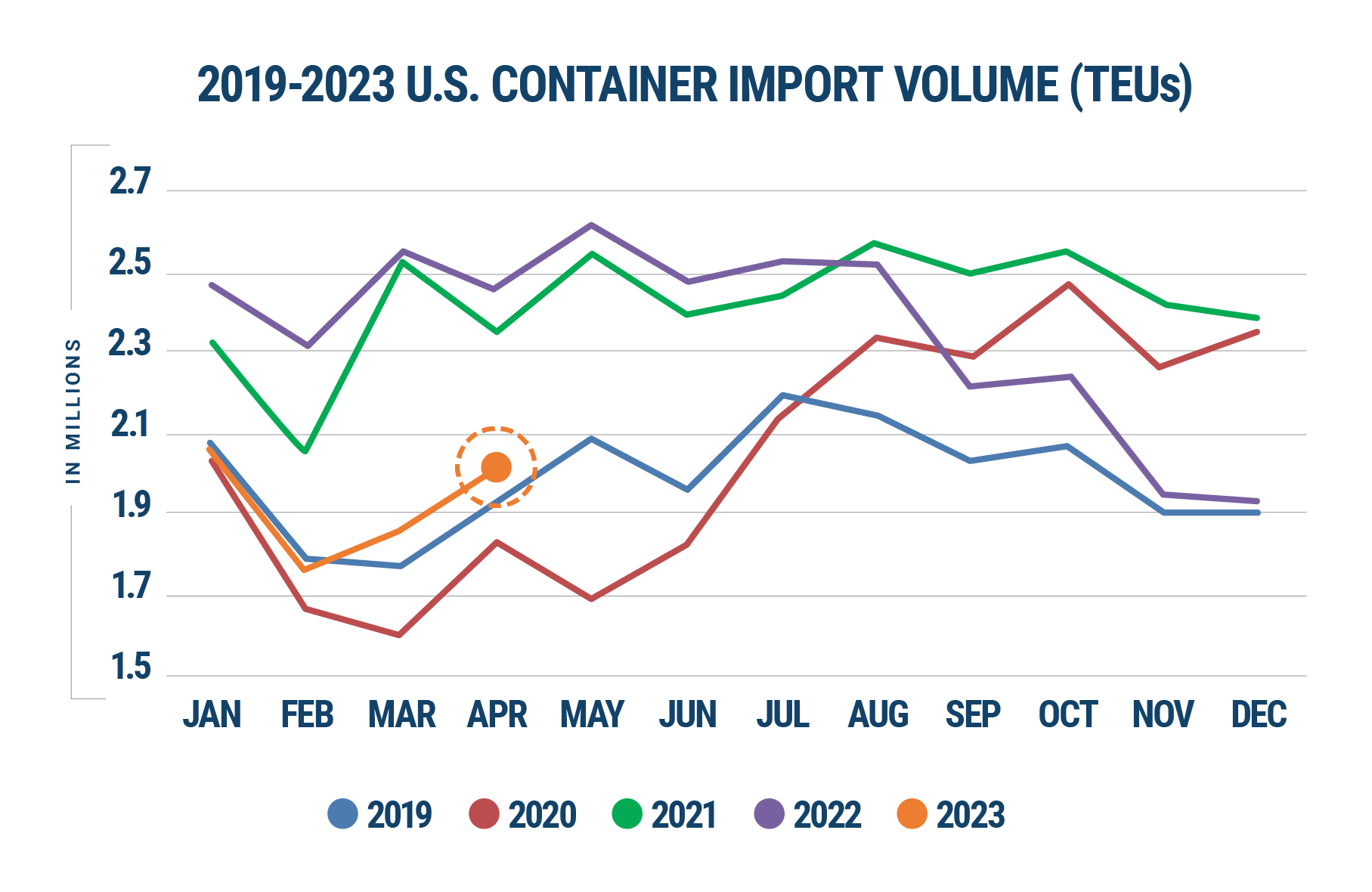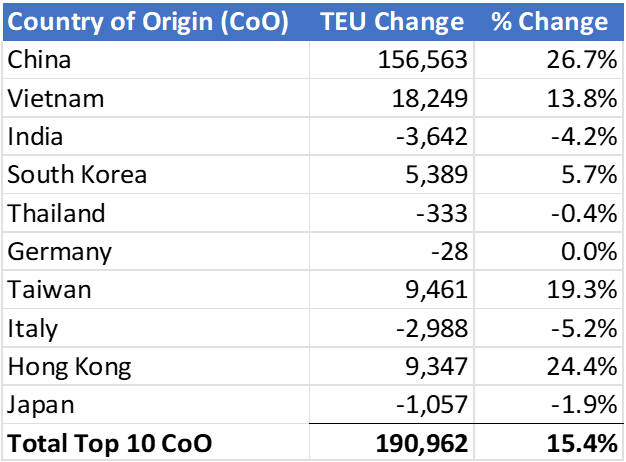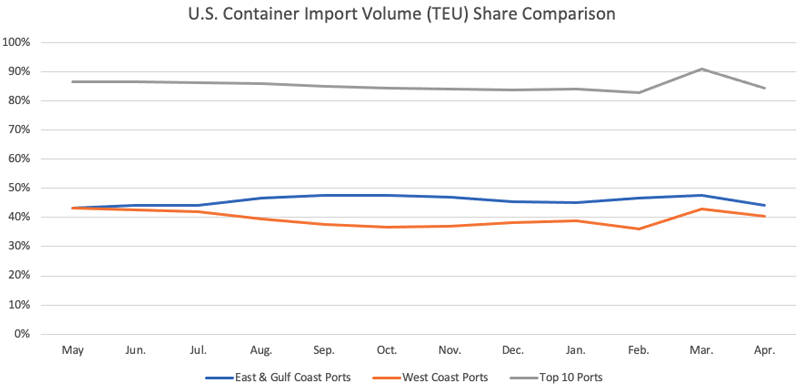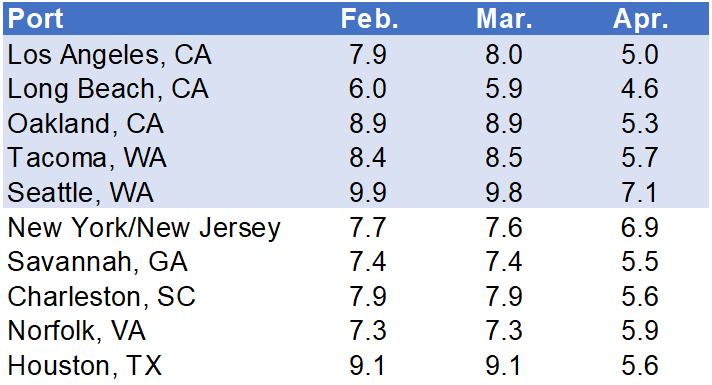The Global Shipping Report
April U.S. Import Container Volumes Increase Significantly from March Driven by Strong Imports from China
U.S. container import volumes in April 2023 increased significantly from March 2023 due to a large increase in imports from China; April volumes also kept pace with pre-pandemic 2019 volumes. Despite overall volume increases, delays were reduced significantly at all ports. The West Coast labor negotiations appear to be progressing, but the contract has still not been sorted out. The May update of the logistics metrics Descartes is tracking shows continued consistency with pre-pandemic import volume seasonality and signs that a number of the challenges to global supply chain performance in 2023 are abating.
In this Article...
- toc
U.S. container imports continue to follow 2019 volume trend.
April 2023 U.S. container import volumes increased 9.0% from March 2023 to 2,020,197 TEUs (see Figure 1). Versus April 2022, TEU volume was down 17.8%, but up 5.3% from pre-pandemic April 2019. The strong growth in container import volume in April continued to track to 2019 volumes for the first four months of 2023 with a difference of 1.5% for the same period in each year.
Figure 1: U.S. Container Import Volume Year-over-Year Comparison

Source: Descartes Datamyne™
Examining the increase in import volumes from March to April in the previous six years, April 2023 volumes show a representative increase from March of the same year (see Figure 2).
Figure 2: March to April U.S. Container Import Volume Comparison

Source: Descartes Datamyne™
For the top 10 ports, overall U.S. container import volume in April 2023 was up by 167,174 TEUs versus March (see Figure 3). The Port of New York/New Jersey showed the greatest overall container volume increase (54,466 TEUs), followed by the Port of Savannah (24,923 TEUs). This growth is somewhat counterintuitive given that China volumes increased dramatically which should favor West Coast ports. Only the Port of Tacoma experienced a month-over-month decline and it was very slight (-1.4%).
Figure 3: March to April Comparison of Import Volumes at Top 10 U.S. Ports

Source: Descartes Datamyne™
As mentioned previously, Chinese imports into the U.S. significantly reversed the downward trend with an increase in April 2023 of 26.7% over March 2023 to 742,692 TEUs, but still down 26.0% from the August 2022 high (see Figure 4). China represented 36.8% of the total U.S. container imports in April, an increase of 5.2% from March, but still down 4.7% from the high of 41.5% in February 2022.
Figure 4: April 2022–April 2023 Comparison of U.S. Total and Chinese TEU Container Volume

Source: Descartes Datamyne
For the top 10 countries of origin, U.S. container import volume in April 2023 increased 15.4% (190,962 TEUs) with China representing the greatest percentage increase (26.7%) as well as 82.0% of the total increase (see Figure 5).
Figure 5: March to April Comparison of U.S. Import Volumes from Top 10 Countries of Origin

Source: Descartes Datamyne
Top ports share declines to fall into line with late 2022 and early 2023 numbers.*
In April 2023, the volume share at top West Coast ports grew again and so did the top East and Gulf ports. Comparing the top five West Coast ports to the top five East and Gulf Coast ports in April 2023 versus March 2023 shows that, of the total import container volume, top West Coast ports increased to 43.9% (up 0.9%) and top East and Gulf Coast ports increased slightly to 47.9% (up 0.2%). Led by growth at the top West Coast ports, the top 10 ports gained share in April 2023 compared to smaller ports, as the top 10 represented 91.8% of all volume compared with 82.8% in January 2023 (see Figure 6).
Figure 6: Volume Analysis for Top Ports, West Coast Ports and East and Gulf Coast Ports*

Source: Descartes Datamyne
*Percentages in this section and in Figure 6, originally published on 5/8/2023, have been corrected as of 6/5/2023
April port transit delays improved significantly for top ports.
In April 2023, overall port transit delays were much lower compared to March 2023 (see Figure 7), and overall, port transit times are at their lowest since Descartes began tracking them in 2021.
Figure 7: Monthly Average Transit Delays (in days) for the Top 10 Ports

Source: Descartes Datamyne™
Note: Descartes’ definition of port delay is the difference as measured in days between the Estimated Arrival Date, which is initially declared on the bill of lading, and the date when Descartes receives the CBP-processed bill of lading.
Positive news on West Coast port negotiations and fuel costs.
There is finally progress with The International Longshore and Warehouse Union (ILWU) and Pacific Maritime Association contract negotiations. The talks continue but the two sides reached agreement on unspecified key points. The contract expired on July 1, 2022; however, business has proceeded as usual with the union and there has been no impact on container processing as has been the case in the past. The final resolution of the agreement could bring Asia-originating containers that had shifted to Gulf and East Coast ports back to major California ports to take advantage of the reduced transit times.
According to the U.S. Energy Information Administration, gasoline costs, a significant contributor to high inflation rates, increased slightly to $3.60/gallon, but down $0.58/gallon from the same time in 2022. Diesel costs are also down slightly to $4.02/gallon and down $1.49/gallon from last April. The diesel decline is good news, but both are likely to remain elevated for the foreseeable future given the disruption of global energy markets because of the war in Ukraine and subsequent sanctions on Russia.
To access other articles that track port congestion monthly, visit the
Global Shipping Resource Center
White Papers
Survey Uncovers Supply Chain Strategies of Top Performing Companies
Surviving Peak Season and Beyond: The Essential Guide to Supply Chain Resiliency

Executive Vice President of Industry and Services
Descartes Systems Group
The Must-Read Guide on U.S. Maritime Ports

See the impact port congestion has had on U.S. imports, and gain insights into how to mitigate risks in your supply chain.
Stay Informed. Download the Report.
Managing supply chain risk: what to watch in 2023.
U.S. container import volume increased in April and continues to track to 2019’s numbers and there are positive signs that point to less supply chain turbulence. Here’s what Descartes will be watching to see if global supply chain performance will continue to improve:
- Monthly TEU volumes between 2.4M and 2.6M. This level will continue to stress ports and inland logistics until infrastructure can be enhanced. April U.S. container import volume continues to follow 2019 levels that are significantly below this range.
- Port transit wait times. If they decrease, it’s an indication of improved global supply chain efficiencies capabilities or that the demand for goods and logistics services is declining. April port wait times decreased significantly at all ports.
- Continuing impact of the pandemic. The spread of COVID subvariants continues to add uncertainty to the trajectory of the pandemic and impact supply chains in unpredictable ways as different countries are affected at different times and for different durations. COVID is still with us but having less impact on supply chain and logistics resources and supply chain performance variability.
- ILWU contract negotiations. The ILWU contract has expired, but to date there hasn’t been an impact on West Coast port operations; however, California AB5 has the potential to cause more disruptions to California port operations. There is progress but no agreement specifics or date for an agreement.
- Inflation and the Russia/Ukraine conflict. Inflation may be the only way to slow down the strong U.S. economy and ultimately help to alleviate the global logistics capacity-related problems that exist. The latest Consumer Price Index report available (March 2023) shows a continuing decline in inflation, but it is still high. Diesel prices continue to decline, but gas prices have risen slightly and remain elevated because of the Russia/Ukraine conflict.
Consider recommendations to help mitigate the pressure of ongoing global shipping disruptions.
April 2023 U.S. container import volumes continue the March 2023 increase and continue to align with pre-pandemic 2019 numbers. Despite volume increases, West, East and Gulf Coast ports saw port transit times decrease significantly. Still, unresolved labor-related issues are keeping importers from moving volume back to the West Coast. This data reaffirms that the pressure on supply chains and logistics operations is continuing to lift, but there are still issues that can cause further disruptions. Descartes will continue to highlight key Descartes Datamyne, U.S. government and industry data in the coming months to provide insight into global shipping. We are staying the course with our current perspectives and recommendations:
Short-term:
- Monitor the impact of California law AB5 on owner-operators serving California ports for potential disruption or degradation of port container processing performance.
- Monitor ILWU contract negotiations for progress.
- Track the spread of COVID variants to determine when they will hit critical parts of the supply chain, especially in China.
- Track ocean shipments and carrier performance as there is still a considerable gap between original ETAs and actual ones.
- Evaluate the impact of inflation and the Russia/Ukraine conflict on logistics costs and capacity constraints. Ensure that key trading partners are not on sanctions lists.
- Focus on keeping the supply chain resources you have, especially drivers. The old adage “a bird in the hand is worth more than two in the bush” definitely applies here. Building trips to reduce stress and improve quality of life to retain drivers is now as or more important than wage increases.
Near-term:
- Continue to look for less congested transportation lanes, including smaller ports, to improve supply chain velocity and reliability. Total transit time is important, but so is supply chain predictability. Evaluate alternative transportation lanes into the U.S., including entry through northern and southern borders and inland ports.
Long-term:
- Evaluate supplier and factory location density to mitigate reliance on over-taxed trade lanes and regions of the globe that have the potential for conflict. Density creates economy of scale but also risk, and the pandemic and subsequent logistics capacity crisis highlights the downside. Conflicts do not happen “overnight” so now is the time to address this potentially business disrupting issue.
Note: This report uses the initial compiled release of U.S. Customs and Border Protection (CBP) data and is subject to revision later by CBP. The revised data can be seen in Descartes Datamyne.
How Descartes Can Help
Descartes Datamyne delivers business intelligence with comprehensive, accurate, up-to-date, import and export information.
Our multinational trade data assets can be used to trace global supply chains and our bill-of-lading trade data – with cross-references to company profiles and customs information – can help businesses identify and qualify new sources. Ask us for a free, no obligation demonstration of our data on a product or trade commodity of your choosing – and keep the custom research we create with our compliments.

